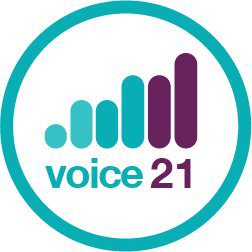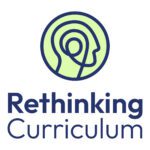Oracy Education in Primary Settings: Voice 21 Case Studies

 This article has been published as part of the Rethinking Curriculum project, kindly funded by The Helen Hamlyn Trust.
This article has been published as part of the Rethinking Curriculum project, kindly funded by The Helen Hamlyn Trust.
Voice 21 have kindly provided two case studies from schools they have been working with to implement an oracy focussed curriculum. These have been working with the Voice 21 resources specifically but many of the challenges and implementation methods can be universally seen in schools who have focussed upon oracy. Thanks go to Voice 21 for sharing these with us and also to Crab Lane Primary, Manchester and Pendle Primary Academy, Lancashire for sharing their journey for us to reflect upon.
Case study 1: Crab Lane Primary
Crab Lane is a primary school in Manchester. They were accredited as a Voice 21 Centre of Excellence in 2022. 55% of the students are eligible for Free School Meals.
At Crab Lane Primary School, oracy practice across the school is underpinned by the idea that talk is crucial to transforming learning. A significant portion of students enter the school without the language and communication skills necessary to fully access the curriculum, so Crab Lane have placed oracy at the heart of their curriculum, giving students the best chance to reach their full potential.
The Oracy Framework
Crab Lane used the Oracy Framework in their curriculum design and a talk-rich learning environment. The framework specifies the oracy skills young people need to develop to deal with a range of different talk situations. It is designed to help school leaders, teachers and students understand the physical, linguistic, cognitive and social/emotional skills that enable successful discussion, inspiring speech and effective communication.
Oracy makes up a large component of Crab Lane’s overarching curriculum. Equipping students with oracy skills and using oracy as a way of elevating learning are both central to Crab Lane’s curriculum design, and using the oracy framework as the foundation has helped Crab Lane to embed oracy across different subjects, phases, and contexts.
Presentational and exploratory talk
One of Crab Lane’s priorities has been to help students speak across a range of topics, and the way that this has been achieved is through the explicit use of exploratory and presentational talk.
Crab Lane created progression maps for oracy, based on the Oracy Framework, that laid out areas of focus for each group of students in relation to the four strands. Each year group has a progression map as well as associated oracy outcomes. These outcomes enable a whole-school understanding of expectations around oracy, and also help teachers plan and scaffold oracy into lessons and monitor where the students are excelling and where they might need extra support.
In nursery, for example, the spring term focuses explicitly on exploratory and presentational talk through storytelling. Firstly, the students work in talk partners to discuss changes that they would make to a known story and discuss how the characters feel through exploratory talk. The students then use presentational talk to retell a story to classmates and parents, and use role-play to perform a puppet show.
This explicit inclusionAn approach where a school aims to ensure that all children are educated together, with support for those who require it to access the full curriculum and contribute to and participate in all aspects of school life of exploratory and presentational talk helps teachers to understand expectations around oracy, and create clear and achievable goals that scaffold students’s learning and development of oracy skills.
How Crab Lane has made this a reality
The oracy team considered how oracy can deepen and enhance students’ learning and started this by implementing oracy groupings, roles and strategies within their own practice. This meant that any potential challenges were removed as staff could see the benefit of an oracy-rich environment. This practice was filtered through to staff during high-quality CPD sessions and follow up support which empowered teachers across the school. This took the form of staff meetings, filming and discussing oracy in action and team planning meetings. Staff feedback demonstrated that they could see the impact of oracy in classrooms and that they valued the use of oracy for the students at our school.
Oracy groupings were embedded into exploratory talk within classrooms and the impact of this was seen during learning walks and through student voice. Furthermore, teachers were supported with using a range of strategies to develop exploratory talk opportunities in the classroom such as vocabulary wheels, talk detectives and fed-in-facts.
In order to maintain momentum, ‘Let’s Get Talking’ challenges were created on a weekly basis to encourage talk at home and parents/carers shared videos/recordings of their families taking part in the challenges and using the talk roles. In addition, staff included oracy within their lessons on Google Classroom.
Additionally, Crab Lane aligned their oracy practice with their restorative justice approach: the principles of restorative justice provide a number of contexts for students to apply and develop their oracy skills. One way they provided this was through daily check-ins with students. This gave every student the opportunity to speak and be heard and a space to verbalise their thoughts and listen to others.
Crab Lane’s use of groupings, ‘Let’s Get Talking’ challenges, restorative justice approaches, and all of the other strategies and tactics that they used came together to support their overarching oracy-rich curriculum.
Impact on students
Crab Lane has seen a huge impact on their students as a result of oracy, and the impact has increased the more embedded oracy has become across the school. They have seen a significant impact on students’ reading and writing skills, and have also noticed that students are able to share their thoughts, feelings and worries more openly. According to the assistant headteacher, oracy is ultimately making the students happier and increasing their enjoyment in school.
Case study 2: Pendle Primary Academy
Pendle Primary Academy is a primary school in Lancashire. They were accredited as a Voice 21 Oracy Centre of Excellence in 2022. 25% of students are eligible for Free School Meals.
In 2018, Pendle Primary Academy had a period of high staff turnover and decided that this was the perfect opportunity to begin implementing oracy in the school.
Pendle began by looking at their curriculum, to see where they could introduce oracy. They chose to start with their guided reading sequence, a discrete area of the timetable that lent itself to an explicit oracy lesson. The whole staff would look at a chosen text on Monday, complete comprehension questions on Tuesday, and then participate in oracy lessons on Wednesday which used drama, debate and discussion, to deepen understanding of the text.
By beginning with the whole staff in a specific area, the oracy lead was able to teach specific strategies and tools that supported teachers to develop their students’ oracy skills. It also allowed time for teachers to experiment with different oracy approaches and build their confidence.
This confidence was raised in two ways: teaching students to talk, and through talk. Through this training, testing and teaching, staff understood the explicit oracy skills that could be developed as well as the way in which oracy approaches support learning.
This discrete approach to curriculum development has now become embedded across all subjects. The school broadened the reach of oracy through their White Rose maths planning, finding where oracy supported discussion and reasoning. The initial discrete approach meant that staff found it easy to bring the elements that they explicitly taught in guided reading into other lessons. Staff are now responsible for planning specific oracy approaches into all subjects in a deliberate and progressive way and for designing presentational outcomes for some units of work.
To support this longer term aim for oracy, Pendle introduced the idea of progression in oracy based on the Oracy Framework. They began by setting oracy targets for Year 1/2 students, Year 3/4 and Year 5/6. This gave staff guidance on the skills that students should be learning at different age phases, and how those skills built upon each other.
After implementing the progression maps, the school realised, through their monitoring processes, that not all of the targets were being met. Teachers were spending too much time on one of the targets, and then others were getting missed. They were then able to quickly identify where the issues were in their oracy practice and adapt and improve their approach, changing the progression maps over to a year group by year group approach, rather than two together.
The new progression maps included no more than 12 oracy targets per year, which also felt more manageable. After the progression maps were implemented, Pendle continued with explicit oracy lessons on Wednesdays, which gave teachers plenty of time to work towards their 12 targets. Additionally, teachers were expected to continue revisiting each target within the wider curriculum time, which helped to further embed oracy in lessons and help students progress.
This approach also gave teachers the freedom to plan their oracy lessons in whatever way suited them best. Some teachers would introduce most of the targets in the first term and then continue to revisit them whilst others would choose to bring in targets with the topics that they felt were best suited to each.
The targets also provide a way for teachers to monitor students’ progress. Each year group has an online learning journal (Seesaw) where teachers can add the targets and keep track of what has been covered already. They also use a rating system for the students so that they can see each student’s progress against the targets.
By creating a progressive curriculum for oracy and a monitoring system that teachers can use to track student progress, Pendle Primary Academy has been able to successfully create an approach to oracy that is tailored to students of all ages, and can be applied successfully across different subjects. This can be seen across all aspects of the school, from talk-rich classrooms to student-led parents’ evenings to a curriculum with oracy at its heart. According to Joanne, Pendle’s Oracy Lead, the change has been profound:
“I’ve really noticed a change in students; we used to talk about how quiet the children were when they came back after the summer holidays and it took a good couple of weeks to encourage them to start talking. We’ve noticed more and more that that’s shrinking by the year; this year they were straight back into talking and using oracy in class. And I think that’s because they know that’s what we expect as a school.”

 This article has been published as part of the Rethinking Curriculum project, kindly funded by The Helen Hamlyn Trust.
This article has been published as part of the Rethinking Curriculum project, kindly funded by The Helen Hamlyn Trust.








